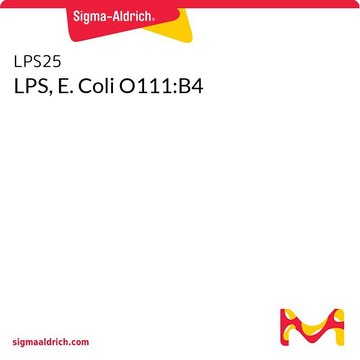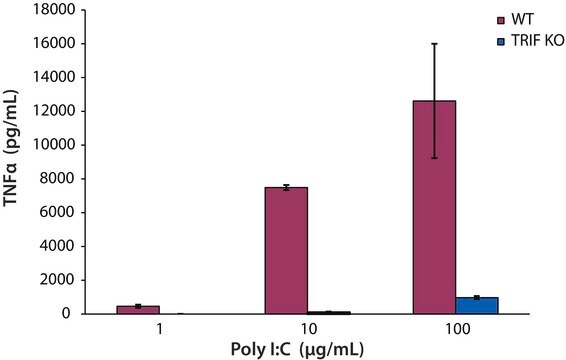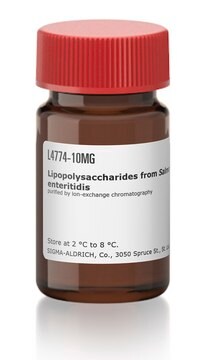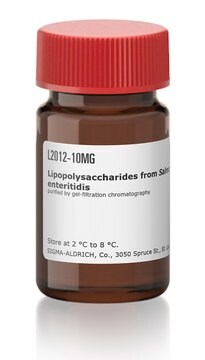L6143
Lipopolysaccharides from Salmonella enterica serotype typhimurium
BioXtra, suitable for cell culture, γ-irradiated
Sinônimo(s):
LPS
Faça loginpara ver os preços organizacionais e de contrato
About This Item
Produtos recomendados
fonte biológica
Salmonella enterica (serotype typhimurium)
Nível de qualidade
esterilidade
γ-irradiated
linha de produto
BioXtra
Formulário
lyophilized powder
purificado por
gel-filtration chromatography
técnica(s)
cell culture | mammalian: suitable
Impurezas
<1% Protein (Lowry)
temperatura de armazenamento
2-8°C
Procurando produtos similares? Visita Guia de comparação de produtos
Aplicação
Lipopolysaccharides (LPSs) are characteristic components of the cell wall of Gram-negative bacteria. LPS and its lipid A moiety stimulate cells of the innate immune system by the Toll-like receptor 4 (TLR4), a member of the Toll-like receptor protein family, which recognizes common pathogen-associated molecular-patterns (PAMPs).
Lipopolysaccharides from Salmonella enterica serotype typhimurium has been used:
- in mice to elicit the secretion of pro-inflammatory cytokines
- to induce cytokine production in monocytes
- to elicit the activation of NF-κB pathway in mouse dendritic cells.
- to induce inflammatory response in human colon adenocarcinoma Caco-2 cells
- for stimulation of the catfish peripheral blood leukocytes (PBLs) to study estrogen receptor mRNA expression
Ações bioquímicas/fisiológicas
LPS is a major constituent of the cell wall of most gram negative bacteria. It is a highly immunogenic antigen with the ability to enhance immune responses to soluble antigens. LPS also acts as a specific mitogen for bone marrow derived B lymphocytes from mice, rabbits, chickens, cows, hamsters, and humans.
Reconstituição
Lipopolysaccharides are supplied as lyophilized, γ-irradiated powders. To reconstitute, add 1 ml sterile balanced salt solution or tissue culture medium to the vial (1 mg) and gently swirl until the powder dissolves. Reconstituted product may be further diluted to desired working concentrations using sterile balanced salt solution or tissue culture medium.
Outras notas
To gain a comprehensive understanding of our extensive range of Lipopolysaccharides for your research, we encourage you to visit our Carbohydrates Category page.
produto relacionado
Nº do produto
Descrição
Preços
Palavra indicadora
Warning
Frases de perigo
Declarações de precaução
Classificações de perigo
Acute Tox. 4 Dermal - Acute Tox. 4 Inhalation - Acute Tox. 4 Oral
Código de classe de armazenamento
11 - Combustible Solids
Classe de risco de água (WGK)
WGK 3
Ponto de fulgor (°F)
Not applicable
Ponto de fulgor (°C)
Not applicable
Equipamento de proteção individual
Eyeshields, Gloves, type N95 (US)
Escolha uma das versões mais recentes:
Já possui este produto?
Encontre a documentação dos produtos que você adquiriu recentemente na biblioteca de documentos.
Os clientes também visualizaram
Guangwei Xu et al.
Journal of enzyme inhibition and medicinal chemistry, 33(1), 1089-1094 (2018-06-23)
Indoleamine 2,3-dioxygenase 1 (IDO1) activity links to immune escape of cancers. Inhibition of IDO1 provides a new approach for cancer treatment. Most clinical IDO1 drugs show marginal efficacy as single agents. On basis of molecular docking and pharmacophore modelling, a
Ju Huang et al.
Proceedings of the National Academy of Sciences of the United States of America, 106(15), 6226-6231 (2009-04-03)
Autophagy plays an important role in immunity to microbial pathogens. The autophagy system can target bacteria in phagosomes, promoting phagosome maturation and preventing pathogen escape into the cytosol. Recently, Toll-like receptor (TLR) signaling from phagosomes was found to initiate their
Luke R Iwanowicz et al.
Fish & shellfish immunology, 40(1), 109-119 (2014-06-29)
Estrogens are recognized as modulators of immune responses in mammals and teleosts. While it is known that the effects of estrogens are mediated via leukocyte-specific estrogen receptors (ERs) in humans and mice, leucocyte-specific estrogen receptor expression and the effects of
Chun-Yan Yeung et al.
Gastroenterology research and practice, 2013, 973209-973209 (2013-07-11)
Background. Lactobacillus shows beneficial anti-inflammatory effects on Salmonella infection. The maintenance of the tight junction (TJ) integrity plays an importance role in avoiding bacterial invasion. Whether Lactobacillus could be used to regulate the TJ protein expression and distribution in inflamed
Marie-Elise Bonnet et al.
Pharmaceutical research, 25(12), 2972-2982 (2008-08-19)
The success of nucleic acid therapies depends upon delivery vehicle's ability to selectively and efficiently deliver therapeutic nucleic acids to target organ with minimal toxicity. The cationic polymer polyethylenimine (PEI) has been widely used for nucleic acid delivery due to
Nossa equipe de cientistas tem experiência em todas as áreas de pesquisa, incluindo Life Sciences, ciência de materiais, síntese química, cromatografia, química analítica e muitas outras.
Entre em contato com a assistência técnica




